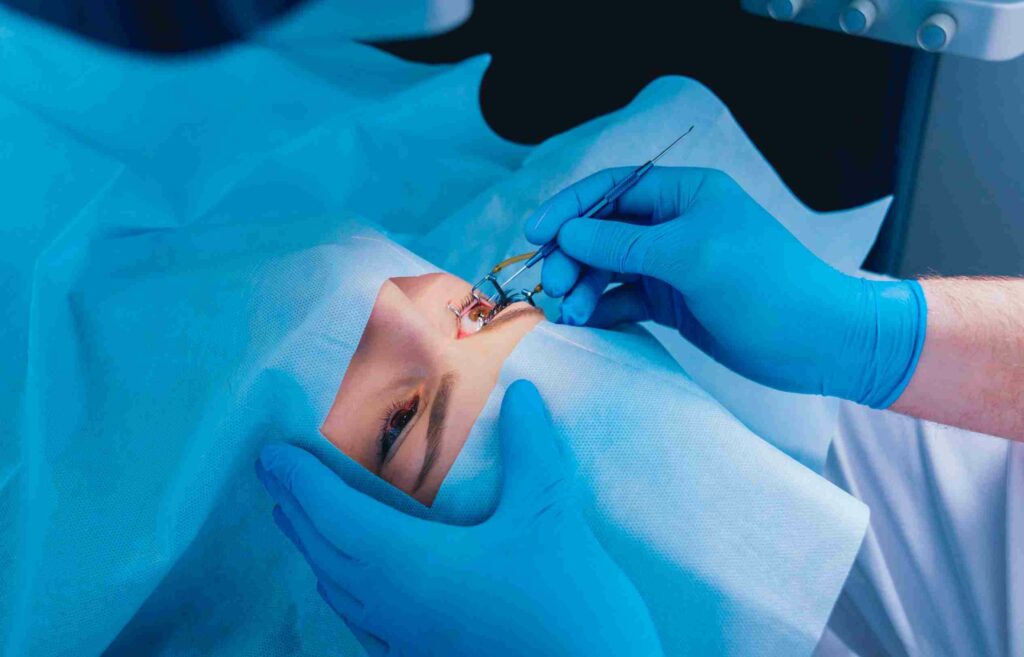Low vision can be a frustrating and limiting condition, but with the advancement of technology and medical procedures, there are now several options for correcting vision problems. Corrective vision surgery is one such option, offering patients a safe & effective way to improve their vision without relying on glasses or contact lenses. In this blog, we’ll explore the different types of corrective vision surgery, their benefits, & how to choose the best option.
Contents
What Is Corrective Vision Surgery?
Corrective vision surgery, also known as refractive surgery, is a surgical procedure that aims to correct common vision problems. Such as myopia (nearsightedness), hyperopia (farsightedness), and astigmatism. Several types of corrective vision surgery use lasers to reshape the cornea of the eye & improve vision. These procedures can reduce or eliminate the need for glasses or contact lenses.
Types Of Corrective Vision Surgery
There are several types of corrective vision surgery available, each with its advantages & disadvantages. Here are some of the most common types:
1. LASIK
 Laser-Assisted in situ Keratomileusis (LASIK) is a two-step procedure that typically takes about 15 minutes per eye. In the first step, the surgeon creates a thin flap in the cornea using a microkeratome or femtosecond laser. The flap is then lifted, exposing the underlying cornea. In the second step, an excimer laser is used to reshape the cornea, correcting the patient’s refractive error. The laser removes a precise amount of tissue from the cornea based on the patient’s unique prescription. After the laser treatment, the flap is repositioned and allowed to heal. Patients typically experience minimal discomfort & see significant improvement in their vision within a day or two.
Laser-Assisted in situ Keratomileusis (LASIK) is a two-step procedure that typically takes about 15 minutes per eye. In the first step, the surgeon creates a thin flap in the cornea using a microkeratome or femtosecond laser. The flap is then lifted, exposing the underlying cornea. In the second step, an excimer laser is used to reshape the cornea, correcting the patient’s refractive error. The laser removes a precise amount of tissue from the cornea based on the patient’s unique prescription. After the laser treatment, the flap is repositioned and allowed to heal. Patients typically experience minimal discomfort & see significant improvement in their vision within a day or two.
2. PRK
Photorefractive Keratectomy (PRK) is an alternative to LASIK that is typically used for patients with thinner corneas or other factors that make LASIK unsuitable. In PRK, the surgeon removes the outer layer of the cornea (epithelium) before using an excimer laser to reshape the cornea. The laser removes tissue from the cornea based on the patient’s prescription, just like in LASIK. Unlike LASIK, however, the epithelium is not replaced but allowed to regrow over several days to weeks. As a result, PRK patients typically experience more discomfort & take longer to recover than LASIK patients.
3. SMILE
Small Incision Lenticule Extraction (SMILE) is a newer type of surgery that is similar to LASIK but uses a femtosecond laser to create a small incision in the cornea instead of a flap. The laser then creates a small piece of tissue (lenticule) inside the cornea, which is removed through the incision. This reshapes the cornea, correcting the patient’s refractive error. The main advantage of SMILE over LASIK is that it preserves more of the cornea’s structural integrity, which can be important for patients with thin corneas or other factors that make LASIK unsuitable.
4. LASEK
Laser Epithelial Keratomileusis (LASEK) is similar to LASIK, but instead of creating a corneal flap, the surgeon loosens the epithelium with alcohol before using an excimer laser to reshape the cornea. The epithelium is then replaced & allowed to heal. LASEK is typically used for patients with thinner corneas or other factors that make LASIK unsuitable.
How To Choose The Best Corrective Vision Surgery?
 Choosing the best corrective vision surgery for you depends on several factors, including your individual needs, preferences, & medical history. Here are some things to consider when making your decision:
Choosing the best corrective vision surgery for you depends on several factors, including your individual needs, preferences, & medical history. Here are some things to consider when making your decision:
- Consult with your ophthalmologist: The first step in choosing the best corrective vision surgery is to consult with an experienced ophthalmologist. They will evaluate your eyes and medical history to determine which type of surgery is best for your needs.
- Understand the benefits & drawbacks of each procedure: Each type of corrective vision surgery has its advantages & disadvantages. Hence, it’s important to understand them before making a decision. For example, LASIK is a popular procedure that offers fast recovery time, while PRK may be a better option for patients with thinner corneas.
- Consider your lifestyle: Your lifestyle may play a role in determining the best surgery option for you. For example, if you participate in contact sports or have a job that requires physical labor, LASIK or SMILE may be a better option than PRK.
- Think about your budget: The cost of this surgery can vary depending on the procedure & the location of the surgery. You should consider your budget when making your decision, & discuss payment options with your ophthalmologist.
- Consider the risks: As with any surgical procedure, there are risks associated with corrective vision surgery. Make sure you understand the risks & potential complications before making your decision.
Ultimately, the best corrective vision surgery for you will depend on your individual needs, preferences, & medical history. Consult with your ophthalmologist to determine which procedure is the most appropriate for you.
What Benefits Can One Expect?
 Corrective vision surgery offers several benefits, including:
Corrective vision surgery offers several benefits, including:
- Improved vision: The most obvious benefit of corrective vision surgery is clearer & better vision. The surgery can correct refractive errors. Such as nearsightedness, farsightedness, & astigmatism. This allows the patients to see more clearly without the need for glasses or contact lenses.
- Convenience: After surgery, patients no longer need to worry about keeping track of glasses or contact lenses or dealing with the discomfort & inconvenience they can sometimes cause.
- Better quality of life: Improved vision can lead to a better quality of life, with patients able to engage in activities such as sports or travel without worrying about their vision.
- Cost savings: While this surgery is initially expensive, it can be cost-effective in the long run. Patients no longer need to purchase glasses or contact lenses, which can be expensive over time.
- Fast recovery time: Most surgeries have a relatively fast recovery time. Patients can return to their normal activities within a few days or weeks.
- Increased self-confidence: Many people feel self-conscious about wearing glasses or contact lenses, & corrective vision surgery can increase self-confidence by allowing patients to see clearly without them.
Overall, corrective vision surgery can significantly improve a patient’s quality of life by providing clearer vision, convenience, cost savings, & increased self-confidence.
Conclusion
Corrective vision surgery is a safe and effective way to correct refractive errors such as nearsightedness, farsightedness, & astigmatism. It offers several benefits, including improved vision, convenience, cost savings, & increased self-confidence. These surgeries have a high success rate, hence consider corrective vision surgery can be the right decision. Whether you choose LASIK, PRK, or another type of surgery, seeking professional help is the first step toward a better vision.
LASIK surgery is a safe 10-minute procedure to help you get rid of glasses. EyeMantra offers the most advanced LASIK options including PRK, Femto Lasik, SMILE surgery, Standard LASIK, ICL, and Contoura vision. If you have any questions on Lasik surgery in Delhi, Lasik surgery cost, and Lasik procedure, call us at 9711116605 or email at [email protected].


